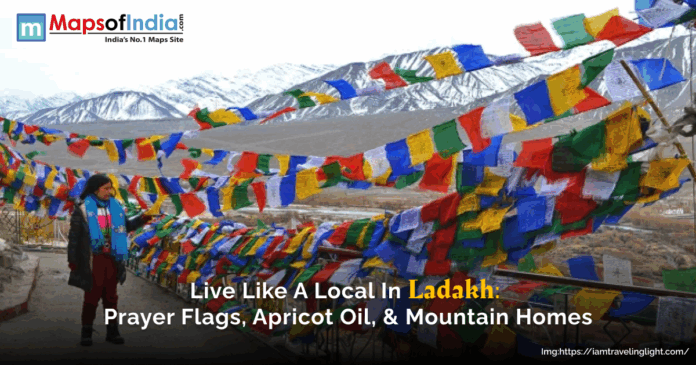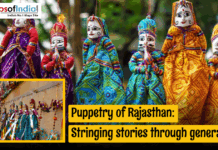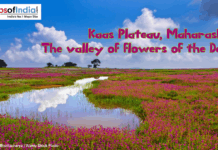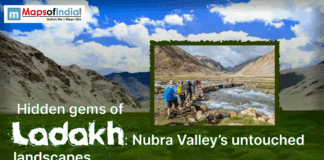Ladakh is a high-altitude desert in northern India. It sits between the Karakoram and the Himalayan ranges. The region has rugged landscapes with a vibrant Buddhist culture. Locals live a simple life resiliently. Prayer flags fluttering can be seen all over Ladakh. Apricot oil nourishes daily life. Mountain homes stand strong against harsh weather. Living like a Ladakhi means embracing these elements and becoming one with this culture. Ladakh is a place that flourishes with natural beauty and elegance. But the locals and the local customs are also unique, which welcomes everyone.
Understanding Prayer Flags
Prayer flags are iconic in Ladakh. They are colourful clothes called lung ta. Lung ta means wind horse. Flags carry sacred mantras and symbols. It is believed that wind spreads blessings across the land. Blessings promote peace and compassion. The five colours represent different five elements. Blue is the sky. White is air. Red is fire. Green is water. Yellow is earth. Hanging flags is a spiritual act for locals. Locals hang them on auspicious days. They place these flags at high points like passes or rooftops.
It is said that to live like a local, you need to hang prayer flags. Visit Thiksey or Hemis monastery. Monks can bless your flags. Choose windy spots for placement. It is believed by locals that wind carries prayers far. It is also believed that touching the flag to the ground is not good; they never let flags touch the ground. From time to time, they replace faded flags. Faded flags mean they have lost their potency. This practice ties tourists to Ladakh’s Buddhist roots. This practice also honours harmony with nature.
Using Apricot Oil
Apricots are grown in Ladakh for their short time in summer. They are a key crop taken from Ladakh’s soil. Apricot oil comes from kernels. This oil is used for cooking and skincare. The oil has properties which is rich in vitamins A and E. It moisturises in dry climates. Local women process kernels by hand. This process supports families to earn their daily income and also sustain their local traditions.
Tourists can buy apricot oil in the Leh markets. To buy this, they can also visit villages like Dah or Hanu. Try the Apricot Blossom Festival in spring. Orchards bloom with pink flowers. Stalls sell oil and jams. Learn to use oil in cooking. Add it to tsampa, which is a famous roasted barley dish. It is used for dry skin. Locals swear that it has healing power. Buying local products at local shops supports farmers. It preserves Ladakh’s agricultural heritage.
Staying in Mountain Homes
Homes in Ladakh are built for extreme weather. They need to sustain and stand in extremely difficult weather. These houses use mud bricks and stone. The walls are thick, which keeps the warmth in. These houses have small windows that reduce heat loss and keep the houses warm. Flat roofs collect snow for insulation. Homes often have carved wooden balconies. Prayer flags are used to decorate rooftops. Inside the houses is cozy and warm. Low seating and colourful rugs create warmth. There is a stove at the centre which keeps the space heated.
If you visit Ladakh, stay in a heritage homestay. There are famous homestays that tourists can try, like Nimmu House or Gyap Thago. These homes are centuries old. You get to sleep on traditional bedding. Eat home-cooked meals, which give the authentic taste of Ladakh. Tourists can also help with chores like milking yaks. Learn to make gur gur or butter tea. Most homes in Ladakh use solar power. Because of the surroundings and limited availability, they conserve water and fuel. Staying here shows Ladakhi ingenuity. You feel the region’s sustainable lifestyle.
Ladakhi Food
Ladakhi food is hearty and simple. It helps to sustain life in cold climates. Tsampa is a famous roasted barley flour. Wheat grows in small fields. Potatoes and peas are common crops. Skyu is a thick pasta stew. Thukpa is a warm noodle soup. Momo is are steamed dumpling. Apricots add sweetness to dishes. These are famous dishes. Herbs like thyme are used to flavour meals. The food practices remind you of a hard environment and limited fields. Most of the time, locals eat together. They believe sharing food builds bonds.
If you visit this area, join a cooking class. Learn to roll noodles for thukpa. Make salty butter tea. Visit a traditional kitchen. Homestays serve farm-to-table meals. Ingredients come from nearby fields. Water and fuel are precious. Cooking is efficient. Sharing meals builds community. You learn about Ladakhi hospitality.
Exploring with Local Guides
Ladakh’s landscape is dramatic and spectacular. Snowy peaks that reach over barren valleys. Turquoise rivers carve the land. Locals know every path and story. For tracking and visiting spots, hiring a local guide is best. Walk through the Indus Valley. Visit remote villages like Dah. Drive past apricot orchards. Guides share folklore and sacred sites. You will understand environmental challenges. Water scarcity is a big issue.
As a tourist, you should choose community-based tours. Trek, bike, or ride yaks. These tours support locals. Most households are run on tourism. Try stargazing at night. Ladakh’s skies are clear. Light pollution is low. Locals love the stars. Exploring this way connects you to the land. You respect its beauty and limits.
Joining Festivals
Ladakh’s festivals are colourful and joyful. Hemis Festival is a highlight. It is celebrated in June or July for two days. Monks perform masked dances. Music fills the air. Losar marks the Tibetan New Year. The Apricot Blossom Festival celebrates farming. Stalls sell apricot products. Performances showcase local culture. Festivals bring communities together.
When you are attending the festival, attend it as a local. Dress modestly. Ask before taking photos. Follow customs. It’s their tradition, so show your respect. You can also volunteer with community projects. Help with sustainable farming or schools. You meet warm and resilient people. Festivals show Ladakh’s spirit. They blend faith and survival.
Conclusion
Living like a Ladakhi is immersive. Hang prayer flags for blessings. Use apricot oil for nourishment. Stay in mountain homes for warmth. Eat hearty local food. Explore with guides who know the land. Join festivals for the community. Ladakh’s desert landscape shapes its culture. Simplicity and resilience define life here. The mountains teach patience. The people share warmth. Embracing these practices connects you to Ladakh. You help preserve its unique heritage. This way of life stays with you long after you leave. Ladakh should be on your must-visit places list. But remember, when you visit a tourist destination, respect their culture and try to understand their ways during your stay.





